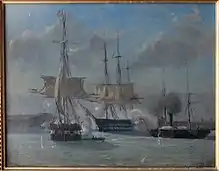Battle of Eckernförde
The Battle of Eckernförde was a Danish naval assault on Schleswig. The Danes were defeated and two of their ships were lost with the surviving crew being detained.[1][2][3][4][5][6] [7]
| Battle of Eckernförde | |||||||
|---|---|---|---|---|---|---|---|
 battle between the navies of Denmark and Schleswig-Holstein at Eckernförde Fjord | |||||||
| |||||||
| Belligerents | |||||||
|
|
| ||||||
| Commanders and leaders | |||||||
|
|
| ||||||
| Strength | |||||||
|
91 artillerymen 10 guns (2 84-pounder guns, 2 24-pounder guns, 6 18-pounder guns) |
1 ship of the line (Christian VIII, 84 guns) 1 frigate (Gefion, 48 guns) 2 steamers (Hekla & Geiser) 3 chases | ||||||
| Casualties and losses | |||||||
|
4 killed 14 wounded |
231 killed 89 wounded 936 captured 1 ship of the line destroyed 1 small ship captured | ||||||
Background
When the fighting resumed after the armistice in 1849, the Danes attacked Sundeved and Schleswig. To support the offensive, the Danish Navy would carry out a diversionary attack on the town of Eckernförde and destroy the German coastal batteries there. A smaller force of 250 troops would also be put ashore to give the impression of a larger landing force. The German flanks were vulnerable to landings along the coasts of Schleswig and such a company could not be ignored by the Germans. Commander Frederik August Paludan was appointed commander of the operation.
The Danish Squadron
The Danish force assigned to the attack consisted of:
- Liner Christian VII (84 guns) - Frederik Paludan
- Frigate Gefion (48 guns) - J. A. Meyer
- The steamships Hekla and Geiser - Christian Krieger
German fortress defense
Eckernförde was defended by two coastal batteries with the following equipment:
- 2x 84-pound bomb cannons
- 4x 18-pound cannons
The crew consisted of 91 artillerymen from the Schleswig-Holstein 5th Fortress Artillery Regiment.
Battle
At 07:30 on the morning of April 5, the Danish squadron sailed into Eckernfördeviken. The bombing of the German batteries began immediately and the northern fortress was soon put out. Suddenly, the wind increased in strength and drove frigate Geifion away from its place in the Danish battle line. When Geiser tried to tow the frigate back, but the steamer was subjected to a murderous firing from the remaining battery. A hit knocked out Geiser's steam engine and left the ship unmaneuverable.
Soon, Christian VII also came out of position, and when Hekla tried to save the liner, she was also seriously damaged by the concentrated attack by the Germans. The strong wind prevented the sailing ships from getting out of the bay and Paludan asked for a ceasefire. During the ceasefire, the Danes made an unsuccessful attempt to move their ships to safety. The fighting resumed at 17:30 and Geifion was soon forced to fly the white flag. Despite the violent bombardment, the crew of Christian VII continued to resist. Paludan, however, soon realized that continued combat was pointless and ordered the ship to be abandoned.
During the evacuation, a fire broke out on board and firefighting attempts by the crew failed. A German non-commissioned officer boarded and demanded that the wounded crew members remain on the ship and that its gunpowder stock not be emptied. Paludan protested with reference to the fire on board, but was eventually forced to agree to the Germans' demands to surrender. Despite this, he still ordered that the gunpowder be thrown overboard. However, the order came late as the fire spread across the ship at a rapid pace. At 20:00, Christian VII exploded. Most of those on board, including many wounded, died immediately from the gunpowder. Paludan watched the shipwreck from ashore.
Aftermath
The attack cost the Danes dearly. Two ships had been lost and over 1,100 sailors had either been killed, wounded or captured, including the Danish naval officer Christian Krieger, who commanded the steamship Geiser and died after the gunpowder exploded underneath the deck. The Schleswig-Holstein losses were lighter with only 4 dead and 14 wounded.
In Fiction
The battle makes an appearance early in the novel We, the Drowned by Danish author Carsten Jensen.
References
- Hans Chr Bjerg/Ole L. Frantzen: Danmark i krig (Gyldendals Bogklubber, 2005), side 286-287
- Hans Chr Bjerg/Ole L. Frantzen: Danmark i krig (Gyldendals Bogklubber, 2005), side 288
- Hans Chr Bjerg/Ole L. Frantzen: Danmark i krig (Gyldendals Bogklubber, 2005), side 289
- Hans Chr Bjerg/Ole L. Frantzen: Danmark i krig (Gyldendals Bogklubber, 2005), side 290
- Hans Chr Bjerg/Ole L. Frantzen: Danmark i krig (Gyldendals Bogklubber, 2005), side 286
- Hans Chr Bjerg/Ole L. Frantzen: Danmark i krig (Gyldendals Bogklubber, 2005), side 290-291
- Carsen Jensen: Vi, de druknede (oversatt av Mie Hidle), Forlaget Press, ISBN 978-8-2754-7275-3 (2007), ISBN 978-8-2754-7391-0 (2010)
